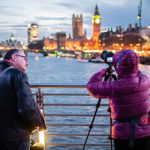How often do you see a beautifully edited image and wish you could give your own photos a similar look? Ben Secret leads this instructional video that shows you, step-by-step, how to recreate any image’s feel using Photoshop:
Secret first analyzes the original image and then uses this to apply it to another image. Here’s how:
1. Set up your images
Secret sets his images so that his inspirational photo is on the left, and his own image is on the right in a separate layer.

2. Compare the contrast of the two images
Create a Color Fill Layer (Layer > New Fill Layer > Solid Color) above both image layers using a medium gray color. Set the blend mode to Color. Open the histogram in RGB Mode (Window > Histogram) and the marquee tool (M). Drag a marquee over the inspiration and over your own photo while looking at the histogram levels to compare contrast. In his example, his own image has a broader range.
3. Match the contrast
Click on the bottom layer again and create a Curves Adjustment Layer (Layer > New Adjustment Layer > Curves). In Secret’s image, he needed to decrease contrast so he dragged the black point up and the white point down to match the other image’s histogram. Change the layer to Luminosity blending, so the colors will not be affected. Then, experiment with various s-curves in order to match the shadow and highlights in the inspiration.
4. Compare the color tone of the images
By this point, if you compare the two images, they should be quite a bit more similar. Turn the color visibility of the Color Fill Layer to Luminosity. In Secret’s example, he can see more blue in the shadows of the inspirational image and more yellows in the highlights.
5. Match the tone of your image to the inspiration
Make another Curves Adjustment Layer below the first one. In the video example, Secret goes to the blue channel and raises the black point while lowering the white point in order to add bluer shadows and more yellow highlights. He also achieves this further by going to the red channel and adding more of a cyan tone by moving the black point up to the right and the white point to the left.
6. Compare the saturation of the images
Click on the top layer and create a new Color Adjustment Layer. For all the color modes, take the black down to -100. For the white, grey, and black modes, bring the black up to +100. This shows the saturation of the images.
7. Make your image match the saturation of the inspiration
Click on the bottom layer and create a Hue/Saturation Adjustment Layer (Layer > New Adjustment Layer > Hue/Saturation) below the two curve layers. Play with the saturation settings until the two images match better.
By this point, your two images should be pretty close in editing. Now, you can find inspiration from your favorite images, and add a new flair to your own.
Like This Article?
Don't Miss The Next One!
Join over 100,000 photographers of all experience levels who receive our free photography tips and articles to stay current:










Leave a Reply